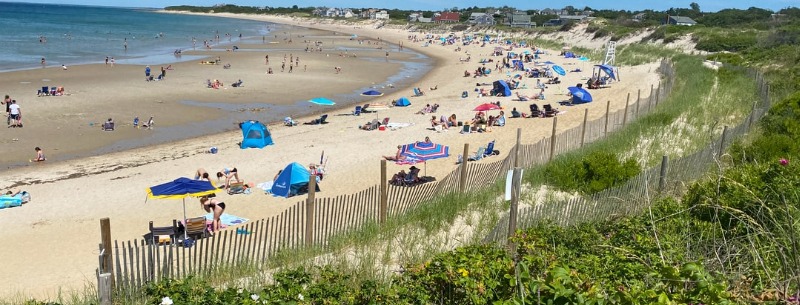Massachusetts Beach Guide
Boston is East Coast America at its best, and spending a few days there is strongly recommended. It’s a place that isn’t content to rest on its laurels – the history is visible, but there’s a great deal of modern life and energy besides, thanks in part to the presence of Cambridge, the home of Harvard University, just across the river.
Several further historic towns are within easy reach – Salem to the north, Concord and Lexington just inland, and Plymouth to the south.
Provincetown, a three-hour ferry ride across the bay at the tip of Cape Cod, is great fun to visit, and the rest of the Cape offers historic towns, lovely beaches – and huge crowds.
Massachusetts beaches:
Cape Cod National Seashore
After the bustle of Cape Cod’s towns, the Cape Cod National Seashore really does come as the proverbial “breath of fresh air.” These protected lands, spared by President Kennedy from the rampant development further south, take up virtually the entire Atlantic side of the Cape, from Chatham north to Provincetown.
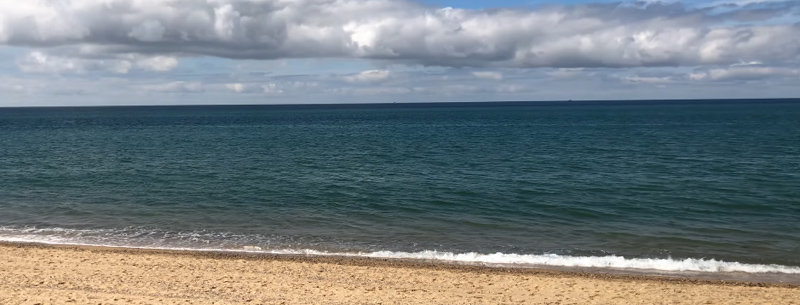
Cape Cod National Seashore comprises 43,604 acres of shoreline and upland landscape features, including a forty-mile long stretch of pristine sandy beach, dozens of clear, deep, freshwater kettle ponds, and upland scenes that depict evidence of how people have used the land.
The Seashore offers six swimming beaches, eleven self-guiding nature trails, and a variety of picnic areas and scenic overlooks.
Sightseeing, trail and beach walking, swimming, historic building tours, fishing, and bicycling are all key activities that can be enjoyed in the park. Ranger-guided canoe tours, surfcasting and shellfishing demonstrations are provided seasonally for a modest fee.
Displays and movies at the main Salt Pond Visitor Center, on US-6 just north of Eastham, trace the geology and history of the Cape.
A road and a hiking/cycling trail head east to the sands of Coast Guard Beach and Nauset Light Beach, both of which offer excellent swimming.
Another fine beach is the Head of the Meadow, halfway between Truro and Provincetown on the northeast shore.
Crane Beach
The four miles of white sand of Crane Beach form one of the most picturesque swimming beaches in all of New England, and is also among the world’s most important nesting sites for the threatened piping plover.
Rustic elevated boardwalks protect an extensive dune habitat complex.
In-season visitors will find lifeguards and rangers, bathhouses with toilets and changing areas, outside showers, picnic tables, bicycle racks, the Crane Beach Store, and water fountains.
Voted “Best Beach” by Best of Boston three years in a row.
Open year-round, daily, 8am to sunset. Allow a minimum of 2 hours, 6.5 hours if also visiting Castle Hill (including Great House or landscape tour) and the Crane Wildlife Refuge.
Horseneck Beach
Spread across nearly 600 acres of barrier beach and salt marsh, Horseneck Beach is one of the most popular facilities in the Massachusetts State Forests and Parks system.
Located at the western end of Buzzards Bay, the sandy, southwest-facing, 2-mile long beach is breezy all year round, providing excellent wind surfing and a dependable respite from sweltering inland temperatures every summer.
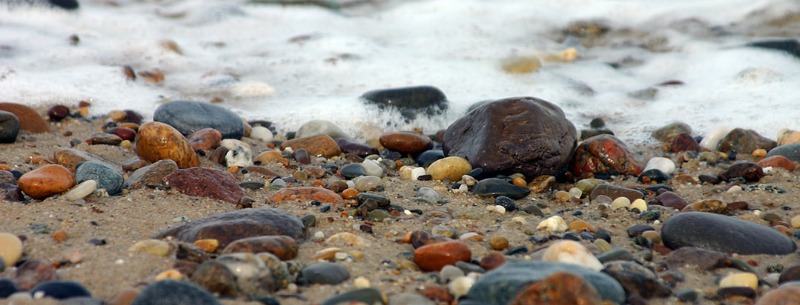
The combination of ocean beach and estuary habitat makes Horseneck one of the premier birding locations in New England.
Behind the dunes near Gooseberry Neck (a rocky headland at the eastern end of the Reservation), is a 100-site campground. The campground office hours are 8am–10pm; the regular camping season is from mid-May through mid-October.
Swimming is only permitted at designated beaches in the reservation, and pets are not allowed at beaches and swimming areas.
All the sand dunes are protected-entrance prohibited.
Martha’s Vineyard
The island of Martha’s Vineyard, just seven miles south of Cape Cod and twenty-four miles long by ten wide, may or may not have been named for Bartholomew Gosnold’s daughter Martha (some ancient maps call it Martin’s Vineyard).
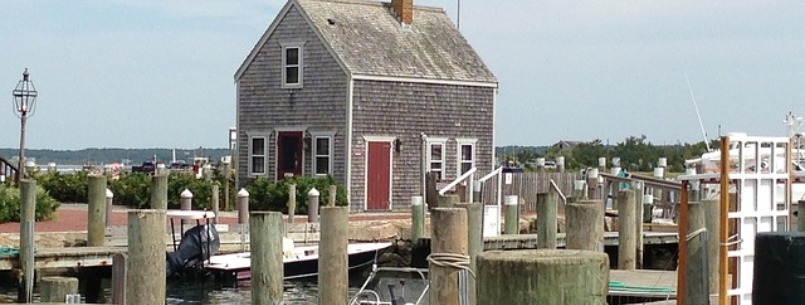
The “Vineyard” part, however, was for its “incredible store of vines”; considerably more fertile than bleak little Nantucket, it has never been quite so dependent on the sea to make a living. Now more than ever, tourism is at the root of the island’s economy, boosted by the gaggle of celebrities.
The popularity of the island with the rich, famous, and/or well-connected has driven up housing prices and lowered availability to extremes. The many second-homeowners who spend the summer here get a better deal than mere day-trippers, though – some of the best beaches are off-limits to nonresidents.
The three principal island communities are connected by a regular bus service and offer full facilities and shops of every kind. They’re quite mellow places to pass a summer’s day, but a little exploring can yield some pleasant surprises, such as quiet beaches and bird-filled lagoons.
Most down-island beaches in Vineyard Haven, Oak Bluffs, and Edgartown are open to the public and just a walk or a short bike ride from town. In season, shuttle buses make stops at State Beach between Oak Buffs and Edgartown.
Nantucket
The thirty-mile, two-hour sea crossing to Nantucket may not be an oceangoing odyssey, but it does set the “Little Grey Lady” apart from her larger, shore-hugging sister, Martha.
The tiny cobbled carriageways of Nantucket Town itself, once one of the largest cities in Massachusetts, were frozen in time by economic decline 150 years ago. Today, this area of delightful old restored houses – the town has more buildings on the National Register of Historic Places than Boston – is very much the center of activity.
In distinct contrast to Martha’s Vineyard, virtually all of Nantucket’s 110-mile coastline is open to the public.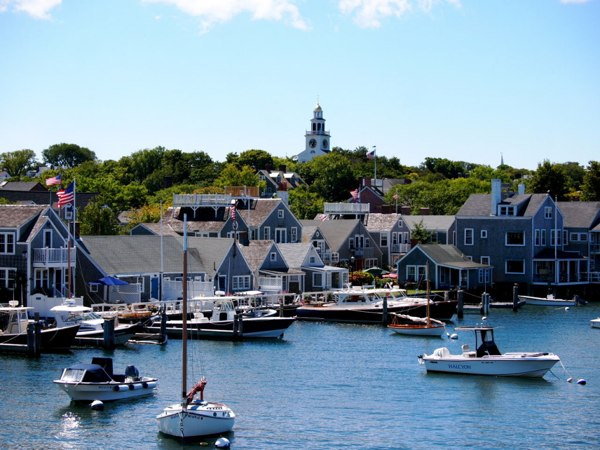
One of the finest Nantucket’s beaches is Coskata-Coatue Wildlife Refuge, best known for its historic lighthouse, many miles of white-sand beaches, and world-class fishing. Rolling maritime dunes cover more than 200 acres and support a variety of animal and plant life, including gray and harbor seals.
Other beaches include families’ favorite Jetties Beach, Dionis Beach, which enjoys the gentle sound surf and steep, small protected Chlidren beach, with park and playground.
About 4 miles from town, in the southwestern quadrant of the island, Cisco Beach enjoys vigorous waves – great for the surfers who flock here, not so great for the waterfront homeowners.
Salisbury Beach
Salisbury Beach is one of the state’s most popular ocean beaches stretching for 3.8 miles along the Atlantic Ocean.
This 521-acre park offers swimming, boating, fishing and camping, and is very popular with trailer campers.
Facilities include a 481-site campground with newly renovated bathhouses, an extensive day-use parking lot, three new comfort stations for the beach going public with over the dune boardwalks, and a new playground and pavilion area. The facility also has two boat ramps that are located on the Merrimack River at the campground’s southern edge.
In the fall and winter, harbor seals often sun themselves on the jetty.
The town of Salisbury has many fun activities to offer for kids of all ages; with a large amusement park and video arcades.
